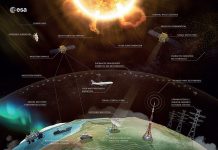With its first view of Earth, NASA’s EMIT Mission achieves milestone towards better understanding of climate effects of mineral dust in the atmosphere.
On 27 July 2022, NASA’s Earth Surface Mineral Dust Source Investigation (EMIT), installed on the International Space Station during 22-24 July 2022, achieved a milestone when it provided its first view of Earth (called ‘’first light’’). The mission aims to map the mineral dust composition of arid regions of Earth to better understand how dust affect climate heating or colling.
The climate warming effect of greenhouse gasses is well understood however there is uncertainty in quantifying climate effects of mineral dust emitted in the atmosphere because of limited measurements of dust composition.
Mineral dust, a component of the soil dust aerosol (an aerosol is a suspension of liquid or solid particles in atmosphere, with particle diameters in the range of 10−9 to 10−3 m.), plays an important role in climate system. In order to estimate different aspects of climate effects of mineral dust it is important to know its origin, concentration and distribution around the globe. Climate modellers try to use different transport models in which parameterization of dust emission, its distribution and absorption and scattering properties are used.
The data on mineral dust and models are currently limited to regional level and cannot be resolved at a global scale. Till date there is no single existing dataset that can describe all the aspects of mineral dust cycle in the global atmosphere.
Mineral dust, which is a major component of global aerosol load can significantly affect the energy balance of the earth system directly by absorption and scattering of solar and thermal radiation and indirectly by interacting with clouds through formation of cloud condensation nuclei (CCN) and changing their properties. In spite of having a reasonably good scientific understanding of processes involving mineral dusts effects on climate system, there is a huge uncertainty in estimation of direct and indirect climate effects of mineral dust, particularly on global scale. A perturbation in radiation balance caused by mineral dust is described in terms of dust radiative forcing (measured in W/m2) is a net change (down-up) in radiation flux caused by mineral dust aerosol. So, any change in mineral dust load in atmosphere will change the radiation balance of a region and may lead to differential heating/cooling affecting the global circulation system and climate. The radiative forcing due to mineral dust depends on several dust properties, for example its optical properties (refractive index), chemical composition, size, shape, vertical and horizontal distribution, its mixing ability with other particles, moisture etc. Not only the circulation of mineral dust in atmosphere but its deposition on the surface also has significant consequences as it may change the surface albedo (the reflecting power of the surface) and affect the melting rate of glacier and polar ice caps.
It is in this context that the EMIT mineral dust measurements are quite significant. It will not only bridge the gap in our knowledge but will also provide the much-needed global data set which will help modellers understand and parameterize the dust effects in climate models.
EMIT measurements will reveal the compositions and dynamics of minerals in the dust around the global atmosphere. In just a second, imaging spectrometer of NASA’s EMIT is capable of capturing hundred thousands of visible and infrared spectra of light produced by scattering/reflection from mineral dust particles and produce spectral fingerprints of the region of the earth. Based upon the colour (wavelength) of the spectrum different components like soil, rocks, vegetation, forests, rivers and clouds can also be identified. But the mission’s major focus would be to measure the minerals in the atmosphere produced from the arid and semi-arid dust producing regions of the world. It would eventually help better understand the impact of mineral dust on climate and help develop a better climate model.
***
Sources:
- JPL 2022. NASA’s Mineral Dust Detector Starts Gathering Data. Posted 29 July 2022. Avaialble online at https://www.jpl.nasa.gov/news/nasas-mineral-dust-detector-starts-gathering-data?utm_source=iContact&utm_medium=email&utm_campaign=nasajpl&utm_content=Latest-20220729-1
- JPL 2022. EMIT Earth Surface Mineral Dust Source Investigation – Objectives. Available online at https://earth.jpl.nasa.gov/emit/science/objectives/
- R. O. Green et al., “The Earth Surface Mineral Dust Source Investigation: An Earth Science Imaging Spectroscopy Mission,” 2020 IEEE Aerospace Conference, 2020, pp. 1-15, DOI: https://doi.org/10.1109/AERO47225.2020.9172731
- Aerosols. Available online at https://www.sciencedirect.com/topics/earth-and-planetary-sciences/aerosol
***




































